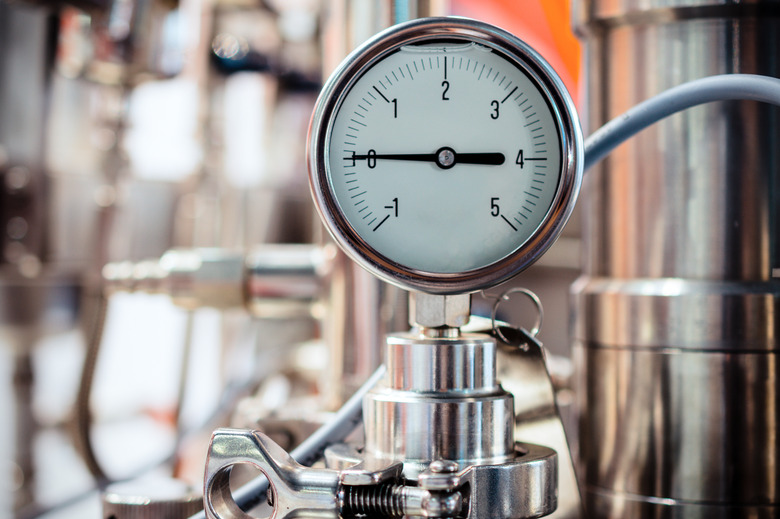What Causes Gas Pressure?
The pressure a gas exerts comes from the motion of its molecules. Gas molecules move about freely, bouncing off container walls and one another. When the molecules bounce off an obstacle, they transfer a small amount of force. The change in direction due to the obstacle results in a change in momentum that pushes on the obstacle.
When many molecules change momentum against a container wall, the pressure can be substantial. Momentum is proportional to speed, and the speed at which the molecules move depends on the temperature. As the temperature of the gas rises, the molecules move faster, and the pressure they exert increases. The facts that gases exert pressure and that the pressure depends on the gas temperature can be used in many interesting ways to perform useful work.
TL;DR (Too Long; Didn't Read)
Gas pressure is caused by gas molecules bouncing off container walls and one another. Every time a molecule changes direction because it hits a wall, the change in momentum results in a small push. Due to the large number of molecules involved, the pushes add up to a noticeable pressure that can be used to run machines and tools.
Definition of Gas Pressure
Definition of Gas Pressure
When the molecules of a gas bounce off the walls of their container, they exert a force. Gas pressure is defined as the force per unit area produced by the gas. Depending on the purpose of the measurement, different units are commonly used. In the English system, the unit of pressure is pounds per square inch. In the metric system, it is newtons per square meter, called a pascal. In meteorology, an atmosphere equals 14.7 pounds per square inch or 101.325 kilopascals.
How Gas Pressure Functions
How Gas Pressure Functions
Gases are fluids, which means they flow from a high-pressure volume to a low-pressure one. Volumes that contain more gas or gas at a higher temperature have a higher pressure than those that contain less gas or are cooler. This means gas can be made to flow from one container to another by increasing the pressure in the first container, either by adding more gas or by heating the container. This property of gas pressure is the basis of many engines and machines used in factories and transportation.
Using Gas Pressure to Do Work
Using Gas Pressure to Do Work
An example of an application that uses gas pressure for transportation is the engine of a car. Gasoline or diesel fuel is added to air and compressed in the engine. The fuel burns, heating up the gas and producing pressure to push on the pistons of the engine. In this case, heat from the burning fuel creates the gas pressure to operate the car engine.
For compressed air tools, extra air rather than heat powers the machines. A compressor adds air to an air tank that delivers air under pressure to the various tools. The tools use the air pressure to screw in bolts, punch holes or nail parts together. The air flows from the high-pressure tank through the tools to the low pressure of the atmosphere. As the air flows out, it powers the tools.
Other examples of gas pressure in action can be found in soda cans, car and bicycle tires, spray cans and fire extinguishers. The molecules that cause gas pressure each contribute a tiny force that can add up to do useful work at the scale of physical objects.
Cite This Article
MLA
Markgraf, Bert. "What Causes Gas Pressure?" sciencing.com, https://www.sciencing.com/what-causes-gas-pressure-13710256/. 9 March 2018.
APA
Markgraf, Bert. (2018, March 9). What Causes Gas Pressure?. sciencing.com. Retrieved from https://www.sciencing.com/what-causes-gas-pressure-13710256/
Chicago
Markgraf, Bert. What Causes Gas Pressure? last modified March 24, 2022. https://www.sciencing.com/what-causes-gas-pressure-13710256/
